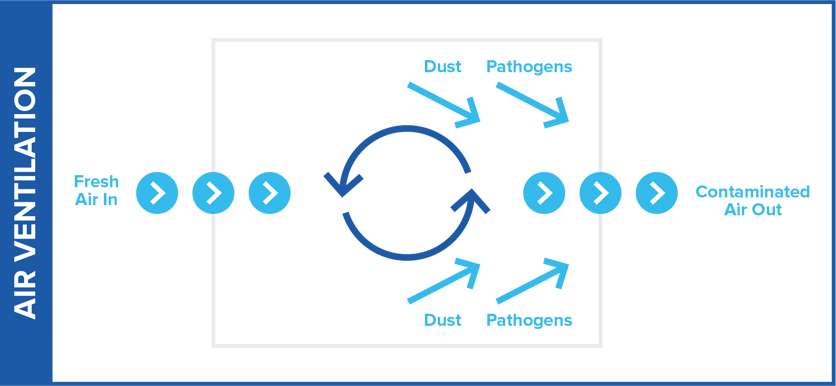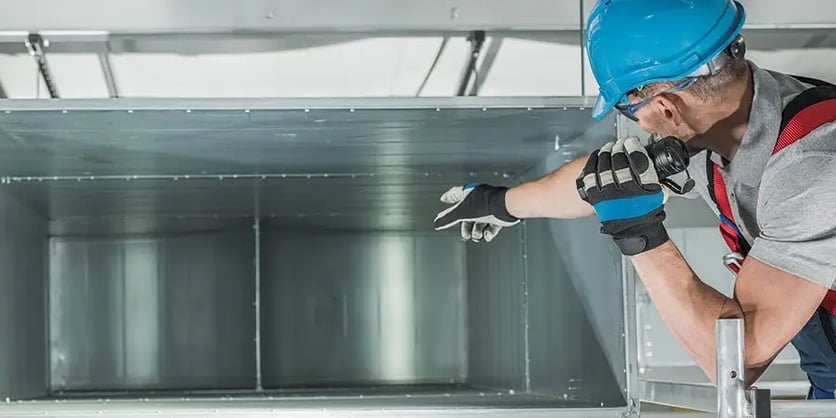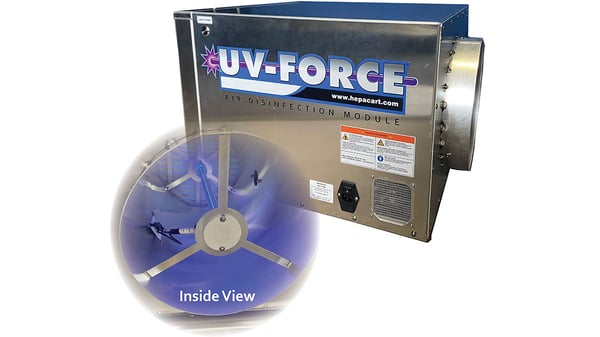Share this
4 Ways to Destroy Airborne Pathogens in Public Spaces
by HEPACART on Oct 28, 2020
Because of COVID-19 and the pending flu season, facilities directors have seen a renewed emphasis on improving indoor air quality.
Although PPE, such as masks and shields, and other precautions like social distancing are necessary to reduce the risk of "near field" transmission of infectious aerosols such as SARS-CoV-2, several studies have shown that the spread of the virus that causes COVID-19 also occurs via airborne particles in indoor environments.
There's no question that the deadly coronavirus has secured the focus of building managers everywhere. And with flu season soon upon us, it's an even bigger task keeping the air inside facilities safe and disinfected.
In this post, we'll share ways to disinfect the air within your facility using a combination of techniques including ventilation, filtration, and UV germicidal irradiation.
1. Ventilation
"Dilution of room air with clean disinfected air is one of the easiest and best-known methods to remove pathogens and to decrease the risk of infections in rooms," wrote Bolashikov and Melikov in 2008, and it's still true today.

Getting fresh air from outside into the building (if it is fresh) is the gold standard for improving indoor air quality. Where fresh outside air is available, and with the right air distribution patterns, harmful concentrations of contaminants can be reduced in direct proportion to the percentage of clean air introduced.
In other words, bring in outside air to match the volume of the inside air, and you've cut the concentration of pathogens in half.
2. Air Distribution
You may have noticed a caveat in that last sentence: with the right air distribution patterns.
Since airflow patterns determine the path of droplets emitted by human respiratory systems, the air distribution system that's bringing in outside air could even enhance transmission instead of reducing it.
Nobody wants to take credit for setting up a pathogen distribution system, and it's a good bet that Hippocrates would not be happy with any arrangement that contributed to encouraging healthcare-associated infections. So, let's first take a look at how to do this safely.

As a first step, be sure to employ an HVAC expert on your multidisciplinary team. That person can work with medical staff familiar with the primary pathogen's characteristics, such as how it's emitted and how it survives between hosts.
Thus informed, the HVAC expert can determine not only the location, direction, and velocity of air outlets that minimizes cross-infection in the facility, but also temperature and humidity settings that are unfavorable to the virus.
3. Air Filtration
To this point, we've been focusing on optimizing your building's HVAC system, but you'll need to manage air pressure in specific zones for more stringent control of pathogens. Equipment for that purpose (such as our HEPAFORCE® Negative Air Machines) may be deployed to isolate a patient room by maintaining slightly lower air pressure, preventing the escape of pathogens during room entry and exit or through the inevitable leak points.
You can use negative air machines to keep pathogens out of a room using positive pressure, such as with extremely immunocompromised patients. Either way, advanced filtration must be part of the picture.

The HEPAFORCE Negative Air Machines uses medical-grade HEPA filters to remove 99.99% of 0.3 microns, particles that are the most difficult to filter. They exceed the filtration efficiency of MERV 16. (If you're dealing with construction dust, you may want to catch the larger particles first with optional MERV-8 pleated or carbon filters.)
While HEPA filtration does a great job cleaning the air by catching pathogens that hitchhike on particulates, it can't physically destroy airborne viruses, bacteria, or mold spores. Which brings us to…
4. Air Disinfection
Germicidal ultraviolet radiation is not new, having been used in a variety of ways since first being employed as a disinfectant more than a century ago. Conventional UV-C has been and is being used for air disinfection, water disinfection, and wastewater treatment, surface and equipment disinfection, and food and beverage disinfection.
Despite generally slow adoption, the use of ultraviolet lamps near ceilings in Tuberculosis clinics, other high-risk settings, and even restaurants for air disinfection has been on the upswing, and it’s working. The authors of a paper entitled Upper Room Germicidal Ultraviolet Systems for Air Disinfection Are Ready for Wide Implementation cite several studies indicating that upper-room germicidal ultraviolet lamps are about 80% effective in curbing the spread of tuberculosis.

The authors go on to make some additional salient points about upper-room germicidal UV:
- It's most useful against diseases transmitted by the airborne route.
- It is advantageous in settings with low ventilation rates.
- Benefits include low power use, flexibility, and a high rate of air disinfection.
- Applications include high-occupancy settings such as jails, homeless shelters, and emergency rooms.
While the world slowly comes around to accepting conventional UV-C, an important refinement called Far-UV has recently arrived. Far-UV is both much more dangerous to pathogens (breaking their chemical bonds) and much safer around humans than UV-C, which has a typical wavelength of 254 nanometers (nM) that can penetrate the eyes and skin. Far-UV has wavelengths between 207 and 222 nM, which studies have shown carry no potential health risks to the eyes and skin.
Far-UV
Far-UV light is extraordinarily effective at destroying pathogens small enough to penetrate a medical-grade HEPA filter. That’s why this type of UV is used in both the UV-FORCE Air Disinfection Module and in the stand-alone room air disinfection unit, the Germbuster 5000 manufactured by HEPACART®.

The UV-FORCE module has ducts for connection with virtually any HEPA-filtered negative air machine on the market, as well as HEPACART's AnteRoom, negative air machines, and dust containment carts. It's the best way to supplement HEPA filtration for thorough air disinfection.
Fighting airborne pathogens is just part of a larger picture: infection control within large indoor spaces, particularly healthcare facilities. To put it all into perspective, we recommend that you check out our free Infection Control For Facilities Managers Guide.
Resources
- Infection Control for Facilities Managers
- Indoor Air and COVID-19 Key References and Publications (EPA)
- Science and Technical Resources related to Indoor Air and Coronavirus (COVID-19) (EPA)
- Standard Practice for Inspection and Maintenance of Commercial Building HVAC Systems (ANSI/ASHRAE/ACCA Standard 180-2018)
- Far-UVC light (222 nm) efficiently and safely inactivates airborne human coronaviruses

